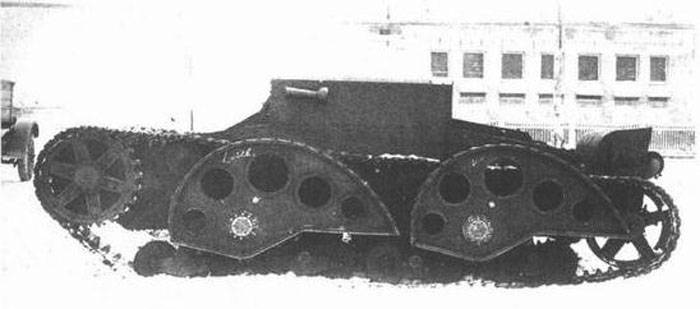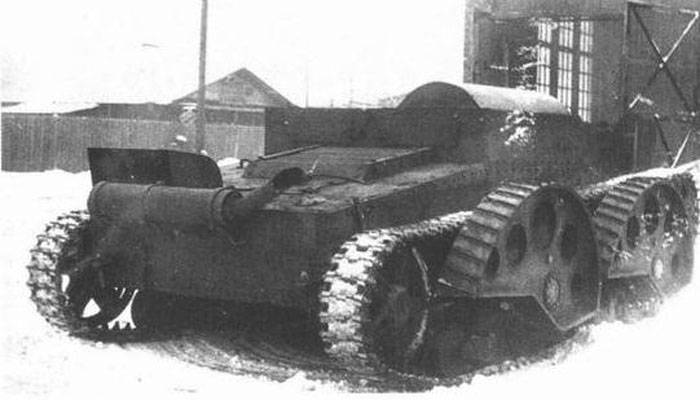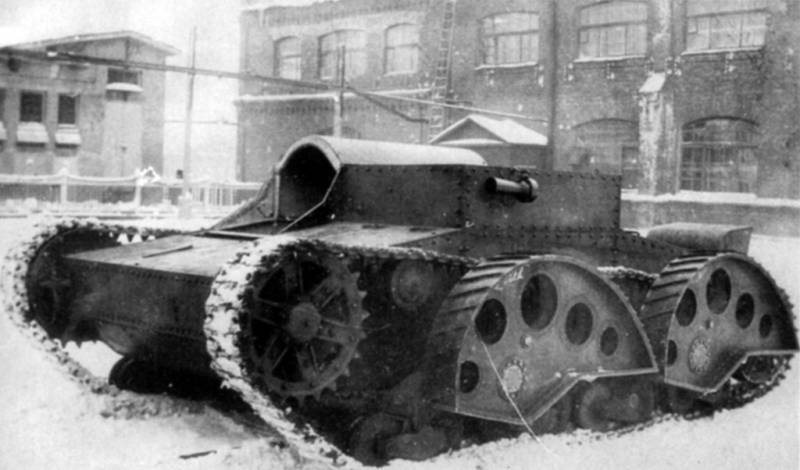Tank to overcome obstacles CCI-2
In the thirties of the last century, together with other Soviet enterprises, the Leningrad Plant No. XXUMX named after. CM. Kirov. In the middle of 185, designer V.V. Lynzer proposed a curious option of a sharp increase in the main driving characteristics, which provided for the use of special accessories. According to the proposed concept, the tank should not move over a difficult obstacle, but jump over it.
Tanks of traditional structures could jump and lift off the ground only in two cases: with the difference in the height of the surfaces of the movement or when they hit a certain springboard. According to the proposal of V.V. Linzer, the tank did not need them, because he had to carry special devices that allow him to perform jumps at any time and in any terrain. At the same time, it became possible to use the accumulated kinetic energy of a moving machine for a jump, without resorting to extremely complex and unjustified decisions.
An interesting proposal was accepted for implementation, and in the shortest possible time the designers of the plant # XXUMX developed a prototype and technology demonstrator. It was proposed to test the new systems with the help of a special tractor vehicle assembled on the basis of the assemblies and assemblies of the T-185 serial light tank. The original structure was noticeably reworked, reducing its mass and equipping it with a number of new devices.
The prototype of the jumping armored vehicle was named “Tank of overcoming obstacles” or CCI-2. Why in the abbreviated name was present exactly two - is unknown. Any information about the existence of the project with the designation of the CCI-1 is missing, which raises questions. As far as is known, only one prototype was developed and built in the original project.
Experienced CCI-2 was intended only to test unusual ideas, and therefore differed from the serial T-26 by the absence of a number of aggregates. First of all, the tank to overcome obstacles did not need a tower. In addition, the armor roof and some elements of the turret box were removed. Instead, the machine received sheets of structural steel. The undercarriage has lost wings, and ammunition and other equipment of the fighting compartment have been removed from the corps. Finally, during the tests, it was proposed to fill the fuel tanks with a total capacity of 290 liters by only a third — this made it possible to reduce the total weight of the vehicle by 130-140 kg.
Being a recycled version of the serial tank, the Chamber of Commerce and Industry-2 retained most of the hull elements. The front assembly, sides, bottom and stern of the machine did not change and, as before, had a thickness of up to 15 mm. The recognizable body shape remained with the frontal part assembled from inclined parts, vertical sides and the engine compartment roof piled back. The layout of the body has changed in accordance with the new tasks. In front of it were still transmission units, behind which the driver was located. The fighting compartment was absent, and some of its volumes were used to install new equipment. In the stern, the engine and part of the power plant units were located.
Instead of the standard turret box, the redesigned T-26 case received new units. Used a box of lower height, assembled from structural steel. Its left part had a large hatch for access to the internal equipment of the tank, and on the right it placed a curved roof, under which there was a driver. At the same time, the hull has retained the regular driver's hatch with a sash in the front leaf opening.
In the aft compartment of the Chamber of Commerce and Industry-2 there was a GAZ-T-26 gasoline engine with 90 horsepower. There also remained a single-disk main clutch associated with the driveshaft. The latter passed along the hull and was connected with a five-speed gearbox of the front arrangement. Through the steering mechanism and single-stage onboard transmissions, torque was transmitted to the front drive wheels.
The existing undercarriage was retained with eight small diameter road wheels on each side. The rollers were installed in pairs on the yokes, which were assembled into two trolleys with leaf springs. In front of the hull was a large drive wheel, in the stern - guide.
The draft CCI-2 provided for the introduction of some new units into the transmission. In addition, the tank's undercarriage was subjected to a certain alteration. As a result, as expected, the machine would be able to jump at any time, without need for height differences or jumps.
The drive of new units was carried out by taking power from the gearbox. Through a system of gearboxes and shafts, at the command of the driver, torque was transmitted to four onboard gears located at the level of the axles of the undercarriage carriages. From these gears, the axle shafts moved out through the pipes on the sides of the hull to the outside. The gearboxes allowed the axles to rotate only in one direction, and in addition, at the right time, they turned off the drive and ensured their free rotation.
The most notable innovation of the TPP-2 project were four eccentrics proposed for installation on the side shafts. On each side of the car there were two such devices. Each eccentric was a product of complex shape, assembled from several parts. The basis of the eccentric was a metal plate with perforations, which was fixed directly on the semi-axis. On the curved face of the plate was provided for the installation of a wide lug with a kind of tread. The broken line, in turn, was strengthened by a metal strip.

Left side of the car. The eccentric design is clearly visible.
According to the designers' idea, during the movement the tank had to develop a given speed, which allowed using special equipment and performing jumps. Approaching the obstacle, the driver had to turn on the power take-off to the eccentrics, as a result of which they turned and came into contact with the ground. Immediately after that, their drive was turned off. The force of friction and the kinetic energy of the machine forced eccentrics to turn and roll on the ground. Due to their special shape, they could throw a tank into the air to a small height. The thrown tank continued to move forward by inertia, as a result of which a real jump would have been obtained. After that, the eccentrics were planned to be returned to the initial position, at which the curved surface with the grouser was at the level of the roof of the hull.
For obvious reasons, the experimental tank was not supposed to carry any weapons. However, when obtaining acceptable results, it would be possible to create a new version of the “tank of overcoming obstacles” that has one or another weapon.
The crew of the prototype was reduced to one person. It was located behind the transmission, with a shift to the starboard side. The designers understood that jumping and falling to the ground would not in the best way affect the driver's comfort, and therefore took certain measures. The driver's seat was installed on hydraulic shock absorbers, absorbing the energy of shocks. In addition, it was equipped with seat belts. The driver had to get into his place through the front hatch, as on the base tank.
Improvements to the serial tank T-26 led to a certain change in size, as well as to a reduction in curb weight. The length of the tank ТПП-2, as before, slightly exceeded 4,6 m. Due to the installation of eccentrics, the total width of the machine reached 3 m. Removing the turret reduced the total height to 1,7 m.
According to known data, the lightweight body weighed 4,77 tons, the gearbox and the special transmission also had 334 kg. Suspension and tracks had a mass of 940 and 748 kg, respectively. Four eccentrics - 484 kg. The total mass of the pilot tank CCI-2, excluding fuel and driver, was determined in 7276 kg. For comparison, the serial tank T-26 weighed 8,3 t. In the test report, this reduction in weight was called insignificant.
From the point of view of running characteristics, the TPP-2 had to correspond to the basic T-26. At the same time, incomplete filling of tanks, which is necessary to facilitate the car, reduced the range of the course. According to the calculations, a special transmission and eccentrics should be used at a speed of 25 km / h. At such a speed, they could send a tank flying several meters long.
In early autumn 1937, the plant number XXUMX them. Kirov began assembling a new type of experienced car. 185 November, she was brought to the factory tests. Checks began with the installation of the tank on the stands and testing of new systems. All units worked normally and performed their functions. At the driver's command, the eccentrics began to move and at the specified point their drive was turned off. On the same day, we tried an electric starter and other systems.
November 27 held the first test with a jump. At the plant’s treadmill, the tank accelerated to 23-25 km / h, after which it turned on the eccentric drive. The equipment worked correctly, but the tank did not rise into the air. Eccentrics stalled on icy ground, as a result of which the tank went skidding and lost speed. After such a check, experts examined the state of the technology. It was revealed six breakdowns and damage to different units. There were cuts of the teeth on the gears, scuffs on the drive axles of eccentrics, etc.
The following weeks were spent on repairing an experienced tank and preparing for new tests. Together with the replacement of damaged parts, other devices were refined. In particular, eccentric lugs were reinforced. 26 December TPP-2 re-entered the landfill. Especially for the new inspections was organized a path of densely rolled snow, sprinkled with sand. In the calculated place off the drive eccentrics, where the tank was supposed to push off and jump, laid wooden flooring.
The first race of December 26 ended in partial success. The tank cranked the eccentrics, then hung in the air. However, turning on the drive of special mechanisms led to a drop in engine speed and a slight reduction in speed in a few moments before the jump. As a result, the flight of the tank was short in all respects and ended up landing on the tracks with a fairly strong blow to the ground.
The second test, which took place on the same day, gave different results. While hanging on eccentrics, the tank began to lose speed. Those could not turn at the right speed, and the machine, rising to the minimum height, landed hard on the tracks. The jump failed. As it soon turned out, the reason for this was the jamming of eccentric axes in the side pipes. In addition, several transmission components were broken from mechanical loads and impacts on the ground, and cracks appeared in different crankcases.

Feed experienced CCI-2
31 December TPP-2 re-entered the test site. Before that, the car underwent repairs, and also lost an air cleaner, which had a negative impact on the maximum speed. Also, the track on which the experimental races were carried out was improved. This time it was planned to check the car at speeds higher than those originally recommended.
Speeding along the track up to the speed of 30 km / h, the “Tank of overcoming obstacles” turned on the eccentrics and hung on them. Then he abruptly lost speed and fell on the tracks. The jump was very conditional, since the tank flew the minimum distance above the ground. This test was stopped due to the lack of any progress.
A few days after that, the Red Army Armored Directorate issued a test report summarizing the results of the entire project. First of all, the authors of the report noted that in practice, the CCI-2 tank confirmed in principle that it was possible to use portable vehicles capable of sending a combat vehicle into flight. However, the prototype itself, which showed this, had a whole set of flaws. As a result, he could not fully implement the ideas underlying the project.
ABTU noted the success of new mechanisms from a design point of view. All new units occupied the minimum volume inside the case, but at the same time gave a noticeable increase in running characteristics. Also, the new design of the driver's seat, which included advanced depreciation means, received a positive assessment.
The main problem of the CCI-2 lay in an insufficiently powerful engine and a relatively low speed. Acceleration to 25-30 km / h did not allow to gain kinetic energy, sufficient for a full jump. In addition, the base chassis of the T-26 tank had too tight suspension, which led to excessively strong impacts when landing and the subsequent destruction of parts. The eccentric drive system also needed to be improved, in which excessive friction was observed, up to the removal of chips and the appearance of scuffing. According to the report, further tests of the CCI-2 did not make sense, and the car should be transferred to the role of a regular tractor in the shops of the plant.
According to the recommendations of the army specialists, the industry had to continue the development of the original proposal, as a result of which new “tanks for overcoming obstacles” could appear with special devices on the sides. However, this did not happen. At the end of the 1930s, Soviet tank building carried out a large number of orders for the supply of serial armored vehicles, and in addition, it developed numerous new projects. Given the shortage of free resources and specialists, the plants could not deal with all the new proposals. For these reasons, the idea of a tank with side eccentrics, despite the approval of the military, was not developed. New designs of this kind were no longer developed or built.
Based on:
http://alternathistory.com/
https://yuripasholok.livejournal.com/
https://shushpanzer-ru.livejournal.com/
Solyankin A. G., Pavlov M. V., Pavlov I. V., Zheltov I. G. Domestic armored vehicles. XX century. - M .: Exprint, 2002. - T. 1. 1905 – 1941.

Information